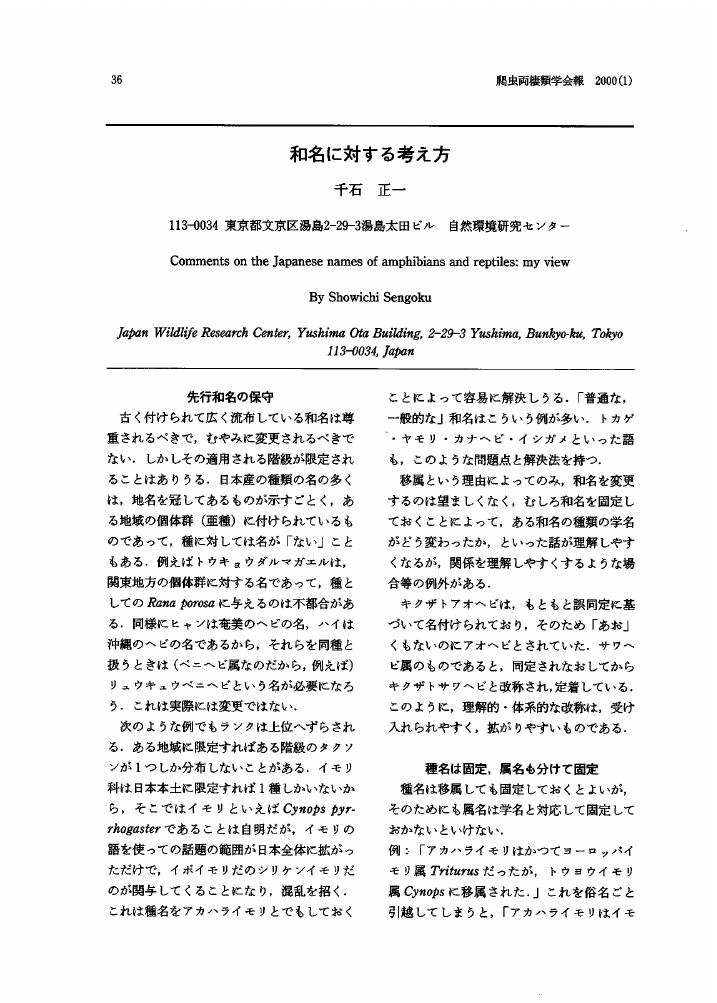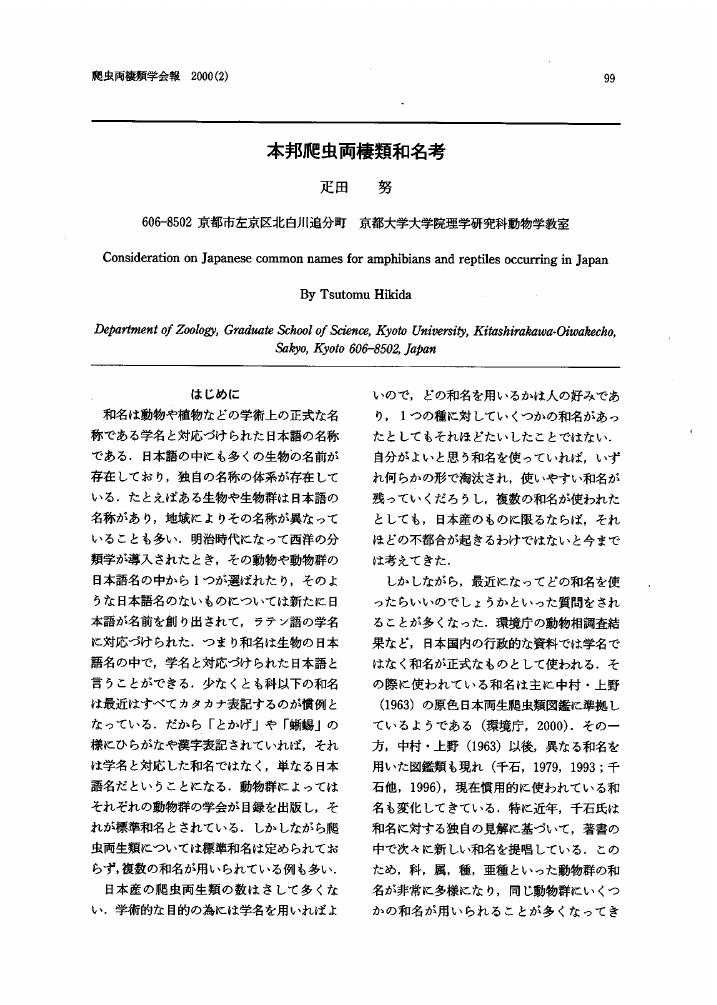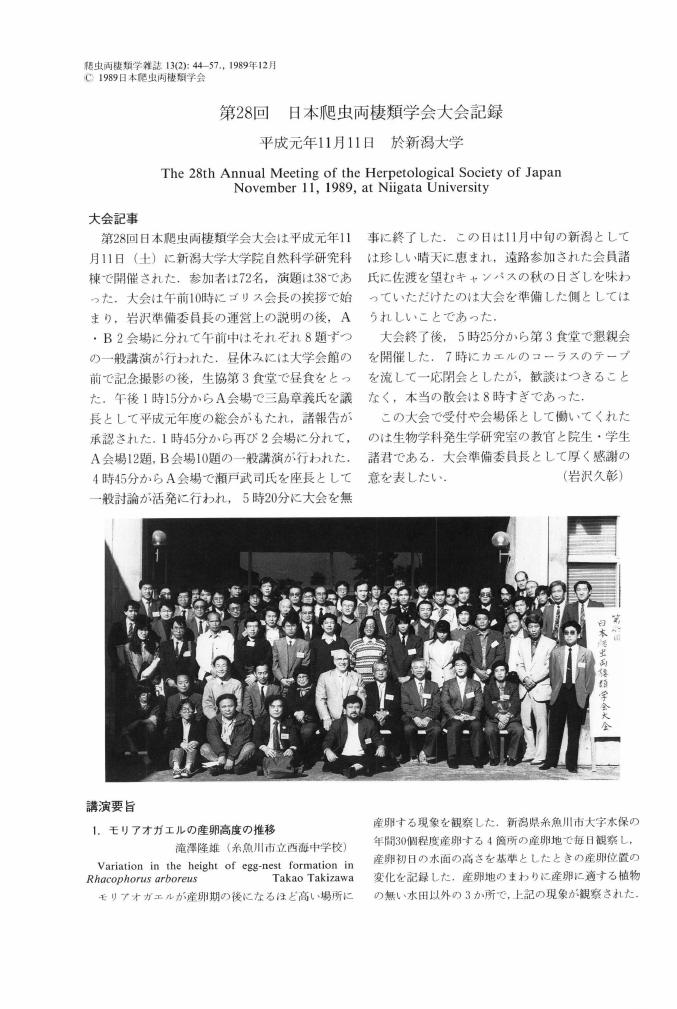2 0 0 0 OA 名古屋市東山動物園における爬虫類のタッチングコーナーについて
- 著者
- 水野 展敏
- 出版者
- 日本爬虫両棲類学会
- 雑誌
- 爬虫両棲類学会報 (ISSN:13455826)
- 巻号頁・発行日
- vol.2001, no.1, pp.21-22, 2001-04-30 (Released:2010-06-28)
1 0 0 0 OA 和名に対する考え方
- 著者
- 千石 正一
- 出版者
- 日本爬虫両棲類学会
- 雑誌
- 爬虫両棲類学会報 (ISSN:13455826)
- 巻号頁・発行日
- vol.2000, no.1, pp.36-39, 2000-03-31 (Released:2010-06-28)
1 0 0 0 OA 本邦爬虫両棲類和名考
- 著者
- 疋田 努
- 出版者
- 日本爬虫両棲類学会
- 雑誌
- 爬虫両棲類学会報 (ISSN:13455826)
- 巻号頁・発行日
- vol.2000, no.2, pp.99-111, 2000-10-10 (Released:2010-06-28)
- 参考文献数
- 22
1 0 0 0 OA 日本産爬虫両生類の和名の変遷と現状
1 0 0 0 OA 静岡県浜松市で確認されたアフリカツメガエル
- 出版者
- 日本爬虫両棲類学会
- 雑誌
- 爬虫両棲類学会報 (ISSN:13455826)
- 巻号頁・発行日
- vol.2004, no.1, pp.24-65, 2004-03-31 (Released:2010-06-28)
1 0 0 0 OA サンショウウオ類におけるマーキング法
- 著者
- 草野 保
- 出版者
- 日本爬虫両棲類学会
- 雑誌
- 爬虫両棲類学会報 (ISSN:13455826)
- 巻号頁・発行日
- vol.2008, no.2, pp.105-116, 2008-09-30 (Released:2011-09-20)
- 参考文献数
- 35
1 0 0 0 OA ニホンアカガエルとヤマアカガエルの染色体分染法による核型
- 著者
- 飯塚 光司
- 出版者
- 日本爬虫両棲類学会
- 雑誌
- 爬虫両棲類学雑誌 (ISSN:02853191)
- 巻号頁・発行日
- vol.13, no.1, pp.15-20, 1989-06-30 (Released:2009-03-27)
- 参考文献数
- 9
- 被引用文献数
- 6
The chromosomes of Japanese brown frogs Rana japonica and R. ornativentris were analyzed with conventional Giemsa staining, C-banding for heterochromatin distribution, and silver staining for nucleolus organizer regions (NORs). R. japonica had 2n=26 chromosomes, centromeric heterochromatin on all chromosome pairs, and NORs on the secondary constrictions on a long arm of No. 9 chromosome. R. ornativentris had 2n=24 chromosomes, pericentric heterochromatin on 5 large chromosomes, and NORs situated in the secondary constrictions of a long arm in No. 10 chromosome. According to the banding karyotype analyses of both species, the process and possible consequences of chromosome number reduction from an ancestral 26-chromosome karyotype is discussed.
1 0 0 0 OA 交尾中のヘビの食欲
- 著者
- 原 幸治
- 出版者
- 日本爬虫両棲類学会
- 雑誌
- 爬虫両棲類学雑誌 (ISSN:02853191)
- 巻号頁・発行日
- vol.7, no.2, pp.33-34, 1977-12-30 (Released:2009-03-27)
1 0 0 0 OA シマヘビによるカメの卵の捕食例
1 0 0 0 OA 鳩間島におけるオオヒキガエルの侵入と生息状況
1 0 0 0 OA オガサワラヤモリの沖縄本島・与那国島からの記録
1 0 0 0 OA トカゲ類の双尾および3尾奇形
- 著者
- 新美 利
- 出版者
- 日本爬虫両棲類学会
- 雑誌
- 爬蟲兩棲類學雑誌 (ISSN:02853191)
- 巻号頁・発行日
- vol.3, no.2-3, pp.14-16, 1969-06-20 (Released:2009-03-27)
- 参考文献数
- 12
A morphological study on the monstered tail of two species of Lacertilia was done with X-ray photograph and Mall's alizalin red-S staining method. One of them, Gekko japonicus, has a forked tail, and the other one, Takydromus tachydromoides, has a triple tail. The former's regenerated tail develops at the level of the left transverse process of the 50th vertebra. It shows normal feature in structure. The latter's primary regenerated tail develops at the caudal part of the 33rd vertebra and the secondary regenerated tail develops at the middle part of the primary regenerated tail. It seems to be constituted with cartilage or chondrin. These specimen were collected in Aichi Prefecture.
- 著者
- 森 哲 戸田 光彦 門脇 正史 森口 一
- 出版者
- 日本爬虫両棲類学会
- 雑誌
- 爬虫両棲類学雑誌 (ISSN:02853191)
- 巻号頁・発行日
- vol.14, no.3, pp.107-115, 1992-06-30 (Released:2009-03-27)
- 参考文献数
- 42
- 被引用文献数
- 5
シマヘビ,アオダイショウ,および,ヤマカガシは直射日光により体温を上げて餌を探しまわる昼行性の捕食者であることがこれまで報告されているが,今回,モリアオガエルの繁殖池で夜間に活動しているのが観察された.これらのヘビの夜間の季節活動のピークは,モリアオガエルの季節活動のピークとよく一致した.観察されたヘビのほとんどは樹の枝上で胴体前部をのばして頭部を幹または下方向に向け静止していた.これらのヘビは下顎または側頭部を幹の表面にぴったりと接していることが多かった.3種のヘビによるモリアオガエルの捕食行動は10例観察された.以上の事実から,これらのヘビは,繁殖期間中に樹の幹を日周活動の通り道に利用しているモリアオガエルを,この位置で“積極的に”待ち伏せしていることが示唆された.ヘビの捕食戦術に影響を与えている要因について考察した.
- 著者
- 疋田 努
- 出版者
- 日本爬虫両棲類学会
- 雑誌
- 爬虫両棲類学会報 (ISSN:13455826)
- 巻号頁・発行日
- vol.2006, no.2, pp.139-145, 2006
1 0 0 0 水中に潜っていたニホントカゲ
- 著者
- 荒尾 一樹
- 出版者
- 日本爬虫両棲類学会
- 雑誌
- 爬虫両棲類学会報 (ISSN:13455826)
- 巻号頁・発行日
- vol.2007, no.2, pp.136-137, 2007
1 0 0 0 OA 水中に潜っていたニホントカゲ
- 著者
- 荒尾 一樹
- 出版者
- 日本爬虫両棲類学会
- 雑誌
- 爬虫両棲類学会報 (ISSN:13455826)
- 巻号頁・発行日
- vol.2007, no.2, pp.136-137, 2007-09-30 (Released:2010-09-27)
- 参考文献数
- 2
1 0 0 0 OA 講演要旨
- 出版者
- 日本爬虫両棲類学会
- 雑誌
- 爬虫両棲類学雑誌 (ISSN:02853191)
- 巻号頁・発行日
- vol.13, no.2, pp.44a-57, 1989-12-31 (Released:2009-03-27)
日本のサンショウウオ類11種の精子の形態と大きさを走査型電顕で調べた.サンショウウオ科とオオサンショウウオ科の種では精子頭部の前端約1/4は先体鞘で被われ,それが外れることにより穿孔体が現れる.イモリ科2種では先体と核は外形から区別できない.イモリ科の精子先端には先体鈎があるが,サンショウウオ科とオオサンショウウオ科の精子に先体鈎はない.オオダイガハラサンショウウオ,キタサンショウウオ,オオサンショウウオの精子の大きさはカスミサンショウウオ属5種の範囲に収まり(163-272μm),イモリ科2種の精子はこれより大形(約490μm),ハコネサンショウウオの精子はもっとも大形(約550μm)であった.












